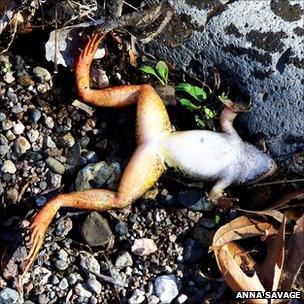Frog killer immune genes revealed
- Published

The lowland leopard frog may have answered the question of why some die and others live
Scientists have taken a big step toward understanding why some frogs survive the fungal disease chytridiomycosis while others quickly die.
A group from Cornell University, US, identified genetic factors that seem to make some individual frogs immune.
This could improve captive breeding schemes, the team writes in Proceedings of the National Academy of Sciences, external.
Chytridiomycosis is slowly spreading across the world, and has already sent a number of species extinct.
Just two years ago, researchers discovered how it kills - by damaging the skin so that key nutrients cannot pass through, resulting eventually in cardiac arrest.
Frogs and other amphibians that have no resistance succumb quickly, with some populations being extirpated in just a few weeks.
Yet some populations and some entire species survive intact, which has long perplexed researchers; and salamanders and caecilians (limbless amphibians bearing a superficial resemblance to earthworms or snakes) appear more resistant as groups than frogs - another mystery.
Complex made simple
The Cornell group collected lowland leopard frogs (Lithobates yavapaiensis) from five places in Arizona.
In the lab, they infected the animals with the chytrid fungus (Batratochytrium dendrobatidis, or Bd).
All the frogs collected from three of the locations died; but from the other two locations, some survived, and fought off the infection completely within two weeks, remaining healthy.
The researchers traced the difference back to regions of DNA that form part of the immune system called the major histocompatibility complex (MHC).
Its role - in humans and other animals, just as in amphibians - is to "present" bits of invaders such as fungi or bacteria to other immune cells, identifying them as things that must be tackled.
"All amphibians (and for that matter, all vertebrate animals) have MHC genes that play the same 'gatekeeper' role in initiating immune responses," said lead researcher Anna Savage.
"So our finding that MHC genotypes contribute to chytridiomycosis outcomes has potential ramifications for all amphibian species currently threatened by Bd."
It appears likely that the two populations whose members survived infection in the lab are the ones that had been most strongly exposed to the fungus in the wild since it was detected in Arizona in the 1970s.
In this case, they probably carry the "resistant genes" because there has already been quite a lot of selection - only the strong have survived.
"It means frogs may have the evolutionary potential to adapt [to Bd]," Ms Savage told BBC News.
"Natural selection can only result in disease adaptation if genetic variation for that trait exists, and we have shown that it does."
The next step along this avenue of research is to find out whether the same thing provides immunity in other species - and whether it can explain why entire species such as the infamous cane toad survive Bd.
Then, conservationists will have to work out how the information can be used.
Breeding success
Ms Savage suggests a role in captive breeding programmes - the last resort for species that cannot remain in their native habitat because it is infested with chytrid.

Chytridiomycosis can kill amphibians in less than a week - depending on their genes
The idea would be to screen amphibians' MHC genes before breeding, to increase the odds of producing Bd-resistant tadpoles.
Prof Reid Harris, an amphibian specialist at James Madison University in Virginia who is trying to develop new treatments for chytrid, described the latest news as "very exciting".
"The study goes a long way toward understanding the genetic basis of resistance to the amphibian chytrid, and it opens up the possibility of selecting for resistance to the disease," he told BBC News.
"However, amphibian defences are multidimensional and include innate immune components and microbial defences.
"It is likely that a successful mitigation strategy will be multidimensional as well."
However, chytrid is only one of the many threats that amphibians face today.
The most profound is loss of habitat, as marshes are drained, forests cleared, and wild areas tamed for human use.
"Although our study provides a new hope that amphibians may bounce back from chytridiomycosis, it does not eliminate the need for human conservation efforts," Ms Savage stressed.
"Habitat loss, invasive species and habitat degradation are other major factors leading to amphibian declines; and if we can work to provide good habitats so that amphibian population sizes and genetic diversity can increase, they will be much more likely to have the genetic capacity to adapt to Bd."
Follow Richard on Twitter, external
- Published1 June 2011
- Published30 April 2010